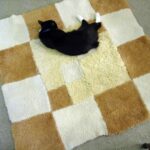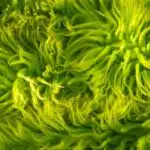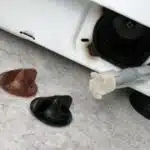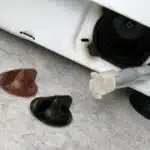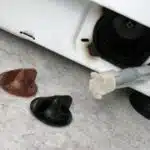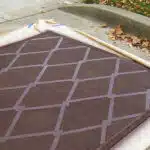As a textile care specialist, it is essential to know how to properly wash and maintain throw rugs. With so many different types of materials and sizes, it can be overwhelming for individuals to determine the best way to clean their throw rugs. However, with proper knowledge and techniques, one can achieve the best results in washing their throw rugs.
Throw rugs are often placed in high traffic areas of the home and tend to accumulate dirt, debris, and stains over time. It is crucial to address these issues promptly by following the correct washing methods to ensure that the rug’s appearance and durability are not compromised. In this article, we will delve into the most effective strategies for washing throw rugs based on their material composition. By following these guidelines, you can guarantee that your throw rug remains clean, fresh-smelling, and lasts for years to come.
Identifying Your Rug’s Material Composition
As a textile care specialist, understanding the type of material your rug is made of is crucial to properly maintaining its appearance and prolonging its lifespan. Before washing your throw rug, it’s important to identify the materials used in its construction.
The majority of throw rugs are made from synthetic materials such as nylon or polyester, which can be easily cleaned with a mild detergent and warm water. However, some throw rugs may be made from natural fibers like wool or cotton, which require more delicate handling during cleaning.
To determine the composition of your rug, check the label for information on the materials used or perform a burn test. A burn test involves taking a small sample of the rug and burning it to observe how it reacts. For example, wool will smell like burning hair while synthetic fibers will produce black smoke and leave behind a hard residue. Once you have identified the material composition of your rug, you can proceed with cleaning it using appropriate methods and products.
Understanding the importance of proper rug care is essential in keeping your throw rug looking its best for years to come. Whether your rug is made from synthetic or natural fibers, following proper maintenance tips can prevent damage and ensure longevity. So before jumping into cleaning your throw rug, take some time to identify its material composition for optimal results.
Understanding The Importance Of Proper Rug Care
Like a gardener tending to their garden, understanding rug maintenance is essential for keeping your rugs healthy and vibrant. Just as plants require proper care to flourish, your rugs also need attention to maintain their beauty and functionality. Rug cleaning techniques are not one-size-fits-all, and the best approach varies depending on the nature of your rug’s fibers and colors.
To ensure that your throw rugs remain clean and fresh, it is crucial to understand the importance of proper rug care. Regular maintenance prevents dirt from accumulating in the fibers, which can lead to discoloration or even damage over time. Proper care also ensures that your rug lasts longer, saving you money on replacement costs.
One of the first steps in maintaining your throw rugs is removing loose debris and dirt. This involves vacuuming regularly with a brushless attachment or gently shaking out the rug outside. Avoid using harsh chemicals or scrubbing too vigorously, as this can damage delicate fibers. By following these simple steps of basic rug maintenance, you can keep your throw rugs looking their best for years to come.
Removing Loose Debris And Dirt
Before washing your throw rug, it is essential to remove loose debris and dirt from the surface. This step is crucial as it prevents any dirt or debris from getting embedded deep within the fibers during the washing process. There are several methods that you can use to remove loose debris and dirt from your throw rug.
One of the easiest ways to remove loose debris and dirt from your throw rug is by vacuuming it. When vacuuming your throw rug, ensure that you use a brush attachment or a low suction setting to avoid damaging the fibers. Start at one end of the rug and work your way towards the other end in long, straight lines. Vacuum both sides of the rug, especially if it has a thick pile.
Another effective method for removing loose debris and dirt from your throw rug is sweeping. Use a soft-bristled broom or a dust mop to sweep over the surface of your rug gently. This technique is particularly useful for rugs with delicate fibers that may get damaged by vacuuming machines. Make sure that you sweep in one direction only to prevent pushing dirt further into the fibers.
In summary, removing loose debris and dirt from your throw rug should be done before washing it for optimal results. The two most effective methods are vacuuming and sweeping with gentle techniques to avoid damaging the fibers’ delicate material. Once this step is completed, you can move on to preparing your rug for washing without worrying about any remaining dirt or debris left behind.
Preparing Your Rug For Washing
Are you tired of walking on a dingy throw rug? Are you ready to give it a good washing but not sure where to start? Fear not, my fellow cleanliness enthusiast! With the right preparation, your throw rug can be restored to its former glory.
Before diving into the washing process, there are a few important steps to take in order to ensure the best results. First and foremost, choose an appropriate detergent for your rug’s material. Using the wrong type of detergent can lead to color fading or damage to delicate fibers. Secondly, inspect your rug for any loose threads or frayed edges. These areas may need special attention during the washing process to prevent further damage. Finally, remove any excess dirt or debris from the rug by shaking it out or using a vacuum with a gentle attachment.
Handling delicate materials requires extra care and attention. If your throw rug is made from silk or wool, consider hand-washing it instead of using a machine. Fill a large basin with cool water and add a small amount of detergent before gently submerging the rug in the water. Use your hands to agitate the water and work the suds through the fibers. Rinse thoroughly and carefully squeeze out excess water without twisting or wringing.
Now that you’ve prepared your throw rug for washing and taken extra care with delicate materials, it’s time to move on to selecting the right washing method. But before we get ahead of ourselves, let’s first cover some important dos and don’ts when it comes to drying your freshly washed throw rug.
- Do air-dry your rug by laying it flat on a clean surface
- Don’t hang dry or use high heat as this can cause shrinkage
- Do flip your rug over periodically throughout the drying process
- Don’t walk on or use the rug until it is completely dry to avoid any damage or mold growth.
Selecting The Right Washing Method
After properly preparing your rug for washing, the next step is to select the right washing method. The two main methods are hand-washing and machine-washing. Hand-washing is ideal for delicate rugs made from natural fibers such as wool, silk, and cotton. Machine-washing, on the other hand, is suitable for larger rugs made from synthetic fibers or those that can withstand the agitation.
When it comes to hand-washing your rug, there are a few things to keep in mind. First, avoid using hot water as it can cause shrinkage and damage to natural fibers. Instead, use lukewarm water mixed with a mild detergent. Gently agitate the rug by hand and rinse thoroughly until all soap residue is removed. Avoid wringing or twisting the rug as this can also damage its fibers.
For synthetic rugs that can be machine-washed, use a front-loading washer on a gentle cycle with cool water and mild detergent. Do not overload the washer as this may cause damage or uneven cleaning. For best results, wash these types of rugs separately from other laundry items. Always check the care label before washing your rug as some may require specific washing instructions such as dry-cleaning only.
Moving onto our next section about hand-washing your rug, it’s important to note that this method requires more time and effort than machine-washing but can be worth it for delicate or antique rugs that require special care.
Hand-Washing Your Rug
Hand-washing your rug can be an effective way to remove dirt and stains while preserving the integrity of the fibers. One of the benefits of hand-washing is that you have more control over the process, ensuring that the rug is not subjected to excessive agitation or harsh detergents. Additionally, hand-washing allows you to target specific areas of the rug that may require extra attention.
However, there are some challenges with hand-washing that should be considered before beginning the process. First, it can be time-consuming and labor-intensive. Depending on the size of your rug, it may take several hours to properly wash and rinse it by hand. Second, you will need a large space to lay out the wet rug for drying, as hanging it up can cause stretching or distortion. Finally, if you are not careful with your water temperature or detergent selection, you may damage your rug’s fibers.
To successfully hand-wash your rug, begin by laying it flat on a clean surface outside or in a bathtub. Fill a bucket with cool water and add a small amount of mild detergent designed for delicate fabrics. Using a soft-bristled brush or sponge, gently scrub the surface of the rug in circular motions until all areas have been cleaned. Rinse thoroughly with cool water until no soap suds remain. Gently press out excess water from the rug using towels before allowing it to air dry flat away from direct sunlight.
Transition: Now that we’ve covered how to properly hand-wash your throw rug let’s explore how machine washing can also be an effective cleaning method when done correctly.
Machine-Washing Your Rug
When it comes to machine-washing your throw rug, there are a few things you need to keep in mind. First and foremost, always check the care label on your rug to ensure that it is safe for machine washing. If the label specifies that the rug should be dry cleaned or spot cleaned only, then avoid machine washing as it may cause damage to the rug.
Next, choose an appropriate detergent for your throw rug. Avoid using bleach or fabric softeners as these can cause discoloration and damage to the fibers of your rug. Instead, opt for a mild detergent that is designed specifically for delicate fabrics.
To avoid any potential shrinkage of your throw rug during the washing process, it is important to use cold water and a gentle wash cycle. High temperatures can cause fibers to contract and ultimately result in shrinkage. Once the wash cycle is complete, remove the rug from the machine and allow it to air dry completely before placing it back on the floor.
• Take extra care when washing rugs with fringes or tassels. • Use a laundry bag or pillowcase to protect your throw rug during machine washing. • Consider adding vinegar or baking soda to help remove odors and stains from your throw rug. • Avoid overloading your washing machine when washing large rugs. • Always follow manufacturer’s instructions when using specialty detergents.
As a textile care specialist, I understand that caring for your home textiles can be overwhelming at times. However, by following these simple steps when machine-washing your throw rugs, you can ensure they remain clean and undamaged for years to come. In our next section, we will discuss how commercial carpet cleaners can assist in maintaining the longevity of your carpets without causing any harm.
Using Commercial Carpet Cleaners
It is often believed that machine washing your throw rug is the best option for achieving optimal results. However, this may not always be the case. Depending on the material and quality of your rug, machine-washing may cause damage to its fibers or lead to color fading. Therefore, it is important to consider alternative methods of cleaning your rug.
Choosing the right cleaner is crucial in maintaining the longevity and appearance of your throw rug. Avoid using harsh chemicals that can strip away natural oils from the fibers and cause discoloration. Instead, opt for a mild detergent or an eco-friendly cleaner that is gentle on both the environment and your rug. It is also recommended to test the cleaner on a small area of your rug before proceeding with full-scale cleaning.
Finding eco-friendly options for cleaning your throw rugs has become increasingly popular in recent years, as more people are becoming aware of their carbon footprint. Some commercial carpet cleaners offer eco-friendly solutions that are biodegradable and do not contain harmful chemicals. Alternatively, you can make your own natural cleaner using ingredients such as vinegar, baking soda and essential oils.
Proper care during cleaning extends beyond choosing the right product- it also involves drying your rug correctly to prevent mold growth or shrinkage. Hang-drying or laying flat in a well-ventilated area are both viable options for drying your throw rug after cleaning. Keep in mind that exposing it to direct sunlight may cause fading or discoloration over time- so be sure to choose an appropriate location based on lighting conditions in your home. Overall, incorporating these tips will help ensure optimal results when washing your throw rugs while protecting both their quality and longevity.
Drying Your Rug Correctly
Proper rug drying is crucial to prolonging the life of your throw rug. After washing, it’s important to remove as much excess water as possible before hanging or laying it out to dry. You can do this by using a clean towel or squeegee to gently press down and absorb the water. Avoid wringing or twisting the rug, as this can damage the fibers and cause them to lose their shape.
To prevent mold growth, make sure your rug is completely dry before storing or using it again. If you’re drying your rug indoors, ensure that there’s enough ventilation in the room to circulate air and prevent moisture buildup. Alternatively, you can hang your rug outside on a clothesline or lay it flat on a clean surface in direct sunlight – just be mindful of any color fading that may occur.
Rug padding can also be beneficial for proper rug drying and maintenance. Not only does it provide extra cushioning underfoot, but it also helps absorb excess moisture and protect both your rug and flooring underneath from wear and tear. There are different types of rug padding available on the market, such as felted wool, rubber, foam, and vinyl. Choose one that best suits your needs based on factors such as thickness, durability, grip strength, and hypoallergenic properties.
Moving forward into avoiding common washing mistakes after properly drying your throw rugs…
Avoiding Common Washing Mistakes
Washing your throw rugs can be compared to baking a cake. Just like how you need to follow the recipe and instructions carefully to get the perfect cake, you also need to pay attention to the washing instructions for your throw rug. One common mistake people make while washing their rugs is using too much detergent or fabric softener. This can leave residue on the rug and attract more dirt, making it look dingy and dirty even after cleaning.
To avoid this and other common washing mistakes, there are a few tips for effective cleaning. First, always check the label of your rug for specific instructions on how to clean it. Some rugs may require special care like dry cleaning or hand washing. If machine washing is allowed, use a gentle cycle with cold water and mild detergent. Avoid using bleach or harsh chemicals as they can damage the fibers of the rug.
Another mistake people make is not properly drying their throw rugs after washing them. Leaving them damp can cause mold and mildew growth which can be difficult to remove later on. It’s best to air-dry your rugs outside in the sun if possible or use a low heat setting in the dryer. To speed up drying time, you could also place towels around and over the rug before rolling it up and pressing down gently to absorb excess water.
As important as it is to avoid common washing mistakes, treating stains and spills on your throw rug is just as crucial for maintaining its appearance and longevity. By following these tips for effective cleaning, you can keep your rugs looking fresh and clean without causing damage or discoloration.
Treating Stains And Spills
To avoid common washing mistakes, it is important to follow the manufacturer’s instructions provided on the throw rugs. They usually come with a label indicating if they can be machine-washed or require handwashing. Always check the rug for any signs of damage, such as frayed edges or holes, before washing. If there are any damages, it is best to have them repaired first before proceeding with cleaning.
When it comes to washing throw rugs, pre-treatment techniques can help remove stubborn stains and spills. For example, if the rug has a coffee spill, blotting it immediately with a clean cloth and cold water can prevent it from setting in. For oil-based stains like salad dressing or cooking oil, sprinkle some baking soda over the stain and let it sit for an hour before vacuuming it up. These pre-treatment techniques can make cleaning much more effective.
DIY cleaning solutions are also great alternatives to commercial cleaners. Using natural ingredients like vinegar and baking soda can be just as effective in removing dirt and grime from your throw rugs without causing any damage or fading of colors. A simple solution of water and vinegar can effectively remove pet urine odors from your throw rugs.
Bullet Point List:
- Always follow the manufacturer’s instructions
- Check for damages before washing
- Pre-treat stains and spills
- Use DIY cleaning solutions
Moving on to treating specific rug care issues, dealing with pet hair and odors requires special attention. Pets shed constantly, leaving their hair all over your home including on your throw rugs. To remove pet hair from your rugs, use a lint roller or vacuum cleaner with a brush roll attachment that will effectively pick up loose hairs on the surface of your rug. To combat pet odor issues in between washes, sprinkle baking soda generously over the rug surface and let sit for several hours before vacuuming it up.
With these tips in mind, you can now confidently wash your throw rugs without making common washing mistakes. Remember to always read the manufacturer’s instructions, pre-treat stains and spills, use DIY cleaning solutions, and take extra care when dealing with pet hair and odors.
Dealing With Pet Hair And Odors
As a textile care specialist, dealing with shedding and combating pet odors are common concerns. First, let’s talk about shedding. Pet hair can be difficult to remove from rugs, especially if the fibers are long and shaggy. The best way to combat shedding is by using a vacuum with a high suction power and rotating brush. This will help to lift the hair from deep within the fibers of your rug.
Secondly, let’s discuss combating pet odors. Pets can leave behind unpleasant odors that can linger in your home even after cleaning. To combat this issue, it is important to regularly clean your rug with a solution specifically designed for pet odor elimination. You should also consider using an air purifier or deodorizer to remove any lingering smells from the air.
By following these tips for dealing with shedding and combating pet odors, you can keep your throw rug looking and smelling fresh for years to come. In the next section, we will discuss how to maintain your rug’s appearance through regular cleaning and maintenance techniques.
Maintaining Your Rug’s Appearance
As a textile care specialist, I understand the importance of maintaining the appearance of your throw rug. Rug maintenance is crucial to ensure that your rug lasts for years and retains its beauty. Regular cleaning can help remove dirt and stains, keeping your rug looking fresh and vibrant. Here are some cleaning tips to follow:
Firstly, vacuum your rug regularly to remove any loose dirt and debris. Be sure to use a low-power setting on your vacuum to avoid damaging the fibers of the rug. If you have pets, consider using a pet hair attachment to pick up any pet hair that may be embedded in the rug.
Secondly, spot clean any spills or stains as soon as possible. Use a mild detergent or carpet cleaner and a soft brush or cloth to gently blot the area. Rinse with water and then blot dry with a clean towel.
Lastly, consider getting your rug professionally cleaned every 12-18 months depending on usage. Professional cleaners have specialized equipment and expertise that can help restore the appearance of your rug.
By following these simple cleaning tips, you can maintain the appearance of your throw rug for years to come. In the next section, we will discuss storage and preservation tips that can further extend the life of your rug.
Storage And Preservation Tips
- Regular cleaning of throw rugs is important to ensure dirt and debris are removed before storage or preservation.
- Air-drying is recommended for most throw rugs, as this prevents fading and shrinkage caused by heat.
- Vacuuming should be done regularly to remove loose dirt and dust, and to reduce the risk of fabric damage.
- It is best to spot clean throw rugs before attempting any deep cleaning or cleaning with a machine.
- For larger rugs, an overnight soak in a mild detergent solution can be used to remove tough stains.
- If a washing machine is used to clean throw rugs, it is important to use the gentle cycle and a mild detergent to prevent fabric damage.
Cleaning Regularly
Regular cleaning of throw rugs is essential for preventing wear and tear. As a textile care specialist, I highly recommend cleaning your throw rugs at least once a month. Regular cleaning can help maintain the rug’s appearance and extend its lifespan.
To clean your throw rug, start by vacuuming it on both sides to remove dust and dirt. Use a mild detergent and warm water to spot-clean any stains or spills. Avoid using harsh chemicals or bleach as they can damage the fibers of the rug. After spot-cleaning, rinse the rug thoroughly with cold water and blot it dry with a clean towel.
In addition to regular cleaning, it’s important to rotate your throw rugs periodically to prevent uneven wear and tear. This will ensure that all areas of the rug are exposed to equal amounts of foot traffic. By following these simple steps, you can keep your throw rugs looking great for years to come!
Air-Drying
Moving on to storage and preservation tips, air-drying is an important aspect of maintaining the quality and longevity of your throw rugs. Air-drying refers to the process of drying your rug without using any heat or mechanical force. This method has several benefits, including preventing shrinkage, retaining the shape of the rug, and reducing the risk of color bleeding. However, there are also drawbacks to air-drying that should be taken into consideration.
One benefit of air-drying is that it is a gentle method that does not subject the rug to harsh conditions. Unlike machine drying or exposing the rug to direct sunlight, air-drying allows for a gradual evaporation process that prevents damage to the fibers. Additionally, this method can prevent shrinkage by allowing the rug to stretch back to its original size as it dries. Another advantage of air-drying is that it helps retain the shape of the rug by preventing warping or buckling.
On the other hand, one drawback of air-drying is that it can take a long time for larger rugs to dry completely. It may be necessary to rotate the rug periodically and allow for several days of drying time before it is completely dry. Additionally, air-drying can sometimes lead to a musty smell if proper ventilation is not provided during the drying process. To avoid this issue, place your rug in an area with good airflow and ensure that it is not exposed to moisture or humidity.
In summary, air-drying is a gentle and effective method for preserving your throw rugs. While there are some drawbacks such as longer drying times and potential musty smells, these issues can easily be addressed with proper care and attention during storage and preservation. By incorporating regular cleaning and appropriate storage techniques into your routine textile care practices, you can enjoy beautiful throw rugs for years to come!
Vacuuming
As a textile care specialist, it is essential to provide tips for maintaining the quality and longevity of throw rugs. One of the most crucial aspects of preservation is regular vacuuming. However, choosing the right vacuum can make all the difference in keeping your rugs clean and free from damage.
When it comes to selecting a vacuum for your throw rug, it is crucial to consider the type of fibers and construction. For example, high-pile shag rugs require vacuums with adjustable height settings that can accommodate their plush texture. Additionally, delicate fibers such as silk or wool may require specialized attachments or lower suction power to prevent damage. By choosing a vacuum that is appropriate for your rug’s needs, you can effectively remove dust and debris without causing any harm.
In addition to regular vacuuming, deep cleaning is necessary for preserving your throw rugs’ quality over time. Deep cleaning involves removing embedded dirt and stains that regular vacuuming cannot eliminate. Some tips for deep cleaning include spot treating stains immediately with a gentle solution and avoiding harsh chemicals that can cause discoloration or fiber damage. By incorporating these practices into your routine textile care regimen, you can ensure that your throw rugs remain beautiful and functional for years to come.
Seeking Professional Help When Needed
Proper storage and preservation of throw rugs is essential to their longevity and overall appearance. However, even with the best care, there will come a time when DIY cleaning techniques are no longer effective. Knowing when to seek professional help can save you time, money, and frustration.
If your rug has been subjected to heavy foot traffic or extensive spills, it may be time for a professional cleaning. Professional cleaners have access to specialized equipment and detergents that can remove deep-set stains and dirt. Additionally, they can identify the type of fibers in your rug and choose the appropriate cleaning method, preventing damage or discoloration.
Attempting to clean a heavily soiled or stained rug yourself may do more harm than good. Over-wetting or using harsh chemicals can cause damage to the fibers or backing of the rug. Furthermore, some DIY cleaning methods may not effectively remove all traces of dirt and grime from the rug’s surface. It is best to err on the side of caution and seek professional help if you are unsure about how to properly clean your throw rug.
In summary, while DIY cleaning techniques can work well for routine maintenance of throw rugs, it is important to recognize when it is time to call in a professional cleaner. By doing so, you can ensure that your rug receives proper care and attention without risking further damage. When in doubt, always consult with a textile care specialist who can provide guidance on appropriate care techniques for your specific rug type.
Conclusion
As a textile care specialist, it is essential to understand the importance of properly washing throw rugs. The first step in achieving the best results is identifying your rug’s material composition. This information will guide you in selecting the right washing method and products.
Before washing your rug, it is crucial to remove loose debris and dirt using a vacuum or brush. Preparing your rug for washing involves checking for any stains or odors that may require additional attention. Pet hair and odors are common issues that require specialized cleaning techniques.
Maintaining your rug’s appearance also involves proper storage and preservation techniques. Storing your rug in a dry, cool place away from sunlight and moisture will prevent damage and fading over time.
In conclusion, taking care of throw rugs requires attention to detail and knowledge of proper washing techniques. By following these steps, you can ensure that your rugs look their best for years to come. Remember, seeking professional help when needed can also save you time and money in the long run. As you wash your rugs with care, imagine yourself as an artist delicately restoring a priceless tapestry, carefully bringing out its beauty with each gentle stroke of the brush.
Image Credits



